By Richard Bater*
Snowpiercer, a 2013 science fiction film by Bong Joon-Ho, takes us on a post-apocalyptic train ride through Earth. In this blog post, Richard creatively refracts the plot of the film to consider several strands of political thought concerning the anthropocene and human-environment relations.
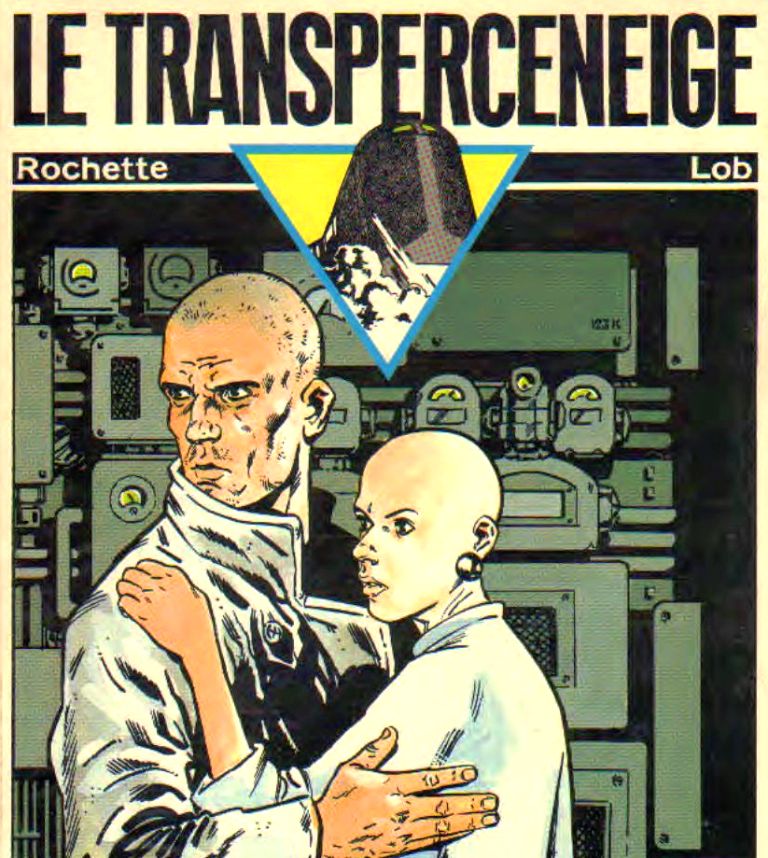
From the original graphic novel Le Transperceniege. Source: ccyberdark.net
Jean-Marc Rochette, a French illustrator and comics creator, wrote his post-apocalyptic sci-fi graphic novel called Le Transperceneige in the early 1980s, soon after the emergence of the global cooling hypothesis and the first World Climate Conference. Its tardy 2013 film adaptation into Snowpiercer by Korean film-maker Bong Joon-ho bears, then, deep relation to a prescient moment in the history of climate science and politics.
Amidst the Hollywood environmental catastrophy-based films that satiate appetites for untroubled thrill, Snowpiercer projects urgency and novelty through forcing science fiction to confront its reticence to address questions of agency, accountability, and power. Untroubled thrill lends characters – human or otherwise – to assume a peculiarly graceless, aseptic existence, with minimal visibility granted to relations and causes, and occluding space for scrutiny and accountability. Here, however, Snowpiercer invites its public into adopting a critical posture towards the complex truth of the who, what and how of environmental destruction. It stimulates its audience to form connections between event, process and outcome. Rather than rendering the catastrophe as a preordained happening, this catastrophe has a villain that is not itself. But the villain is not personified as such; he/she is not the central belaboured character but is instead present implicitly as an unaccountable arrogant order, within which we are asked to locate and question ourselves. In other words, it is a thrill, but a troubled thrill.
Snowpiercer, in this light, is not a sci-fi film whose subject is ecological catastrophe, but rather an exposition of familiar techniques and myths of governing, whose effect has become the ruin of conditions for existence. It strikes to the heart of the myths by which “modern” societies eke out their/our fragile existence. Its effort is exhausted in weaving the threads of the relations between geo, knowledge, authority, power and politics: the complexion of the anthropocene.
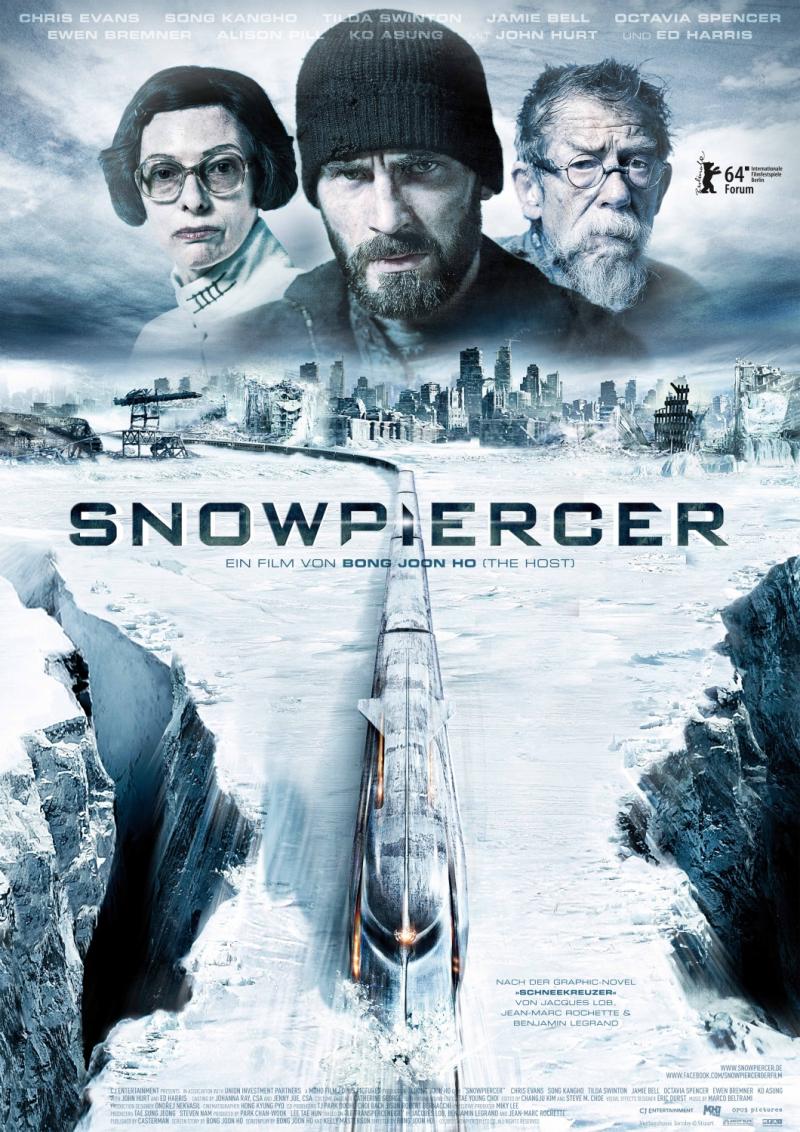
Official Snowpiercer (2013) poster.
The train dubbed the Rattling Arc careers at full pelt on the railroad tracks across the surface of a frosted Earth. It is propelled by a perpetual motion machine, ruled by a perpetual tyranny. No obstacle slows the pace of the Arc’s progress – no corner too tight, no mountain too steep. The Arc is the apparently self-contained, sole miserable repository of denizenry shrugged off Earth-proper by a human experiment gone awry. If a sigh were a pronoun for a collective and its world, cowed into fear and resignation, it ekes-out its existence here, aboard this Arc.
The hubristic techno-chauvanism of a failed experiment to control the ‘threat’ posed by Earth begets yet more hubris to govern the ‘threat’ posed by the subalterns. Anti-politics begets anti-politics; the kernel of the cause the Arc becomes the kernel for the Arc’s tyranny. Organised autarkically for its (rulers’) own perpetuation, the Arc takes for granted its conditions of possibility: a ‘static’ frozen Earth, apparently devoid of life; its unchanging character a predictable space through which the Arc can pass.
And re-pass. During the decades since “the event”, the Arc’s rulers had made themselves the predicate for survival on this planet. An aristocratic ideology of ‘just’ order – of possible living – cut-off, self-referential: hierarchical, exploitative, and permanent. The story of a lifeless Earth ‘beyond’ mattered for preserving the stability of the Arc regime; a constitutive ‘outside’ positioning the Arc’s order as the transcendent, sole possible guarantor of continued living.
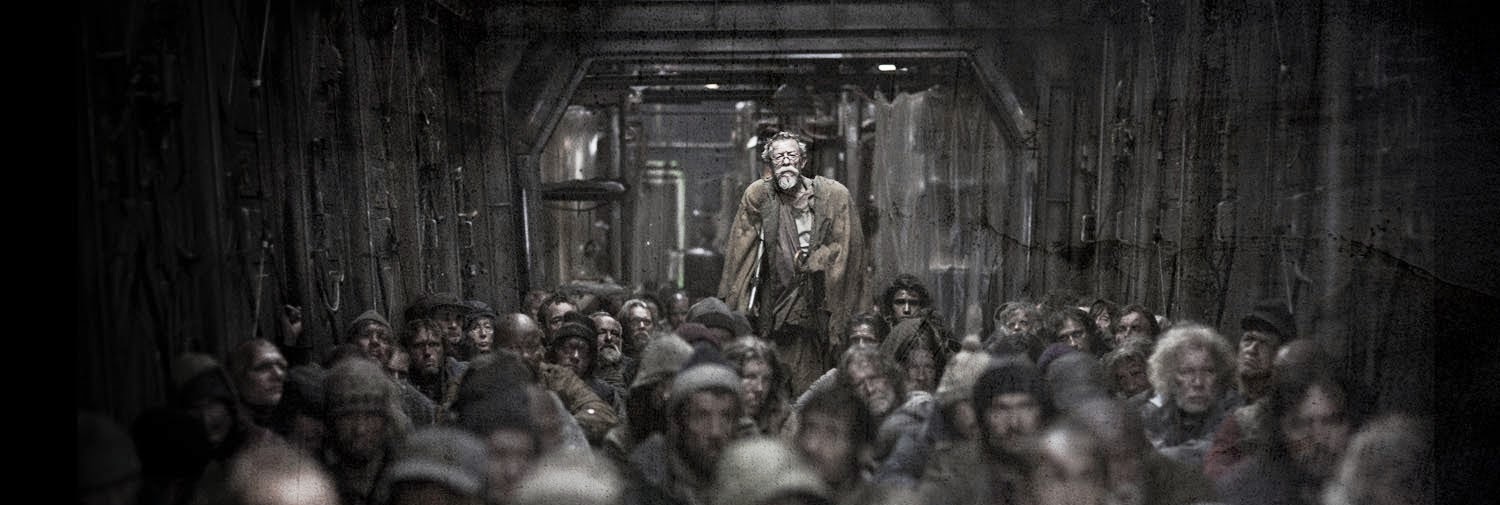
John Hurt plays Gilliam in Snowpiercer. Source: Cinemelodic
In the ravaged rearmost compartment, Gilliam is the good subject who knows “his place”. Poor by means and fearful of change, he seemed always to act charitably towards his companions. But at the same time, he dutifully acts-out the instructions of the Sovereign to stage revolts to be met with repression and mass-murder; to stoke macabre carnivals of the grotesque showcasing immanent death and the fragility of the body.The staged representational erotics of suggestive glimpses – of dreams, of promise – stoked, controlled, then brutally repressed by the Sovereign. The grotesque a linchpin of rule. Gilliam secretly pawns his disheveled, salt-of-the-Earth aspect for the continuance of another’s tyranny. The passion and courage for struggles for justice become colonised, marshaled and inverted.
Such thoroughly postmodern mirages, subterfuges, semblances multiply throughout: brutalised truths, conflicted loyalties, alternating battles. Tolerating – accepting – his place in the order, Gilliam’s charity is part of his contribution to insulating the structure from rupture. Beneath his surface compassion and generosity is deep cynicism: his loyalty to Wilford (the Arc Sovereign) leads him to stoke the idealism of his comrades, to dangle the possibility of release, of nirvana, as a means to test loyalty and purge the non-committed. Staged revolts and orchestrated chaos condemn the weak to death in their unwinnable battles with guards – a calculated strategy of population control through the ‘self-cleansing’ of the disobedient from the social.
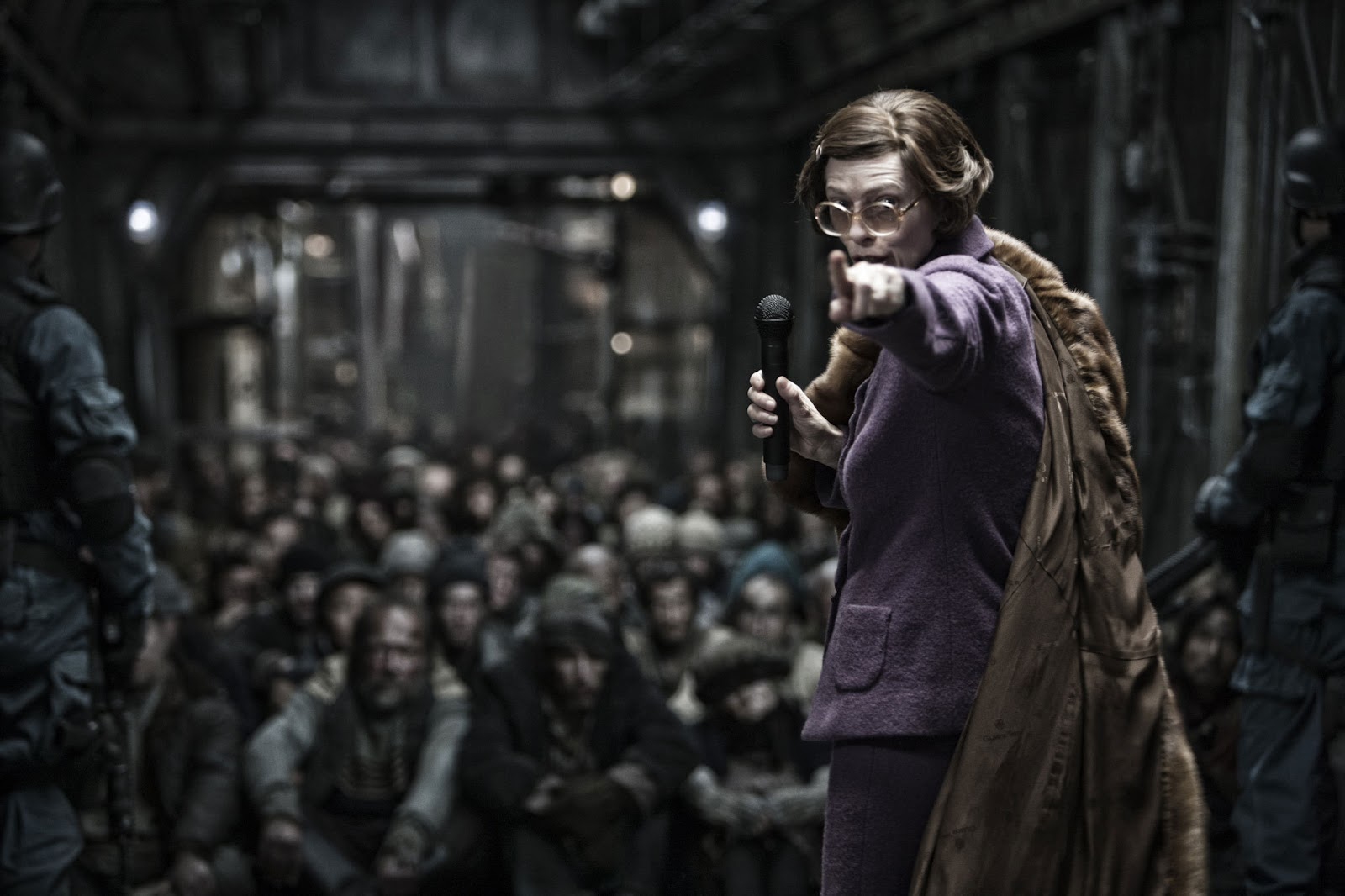
Mason is the Minister, a lackey and enforcer of Wilford’s will. Source: chrishannamtl.files.wordpress.com
The enslaved in the rear compartments of the train never experienced life at the front. Advancing through the carriages, we peer-in on how the higher classes live: each carriage one increment up the socio-economic hierarchy, each sub-group in a relation of occluded, reluctant dependence. Scarcely suppressed contempt, spite, and nonchalance; conditions of relating poisonous to social harmony and justice but conditions that fortify the Sovereign. Social strata upon social strata, penultimate against last; in this quack-social Darwinian hierarchy, each new class bequeaths new vogues of respectability, worth, and aspiration; yet more fissures, more enmities. New fashions, new identities. Progress.
As the perpetual motion machine enables the train to progress ceaselessly through the landscape ahead, the mode of political organisation embeds itself through the incessant, exhaustive churn of the exploited and the dammed; the conscientious-but-doomed idealists and useful idiots. The conflicting identities, lifestyles and loyalties as the perpetual (social) motion machine for the fragmentation, control and exploitation of the collective.
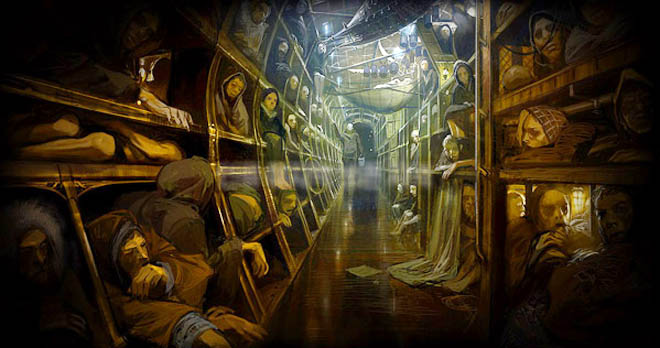
Concept art of the claustrophobic Dickensian world of the train’s poorest inhabitants. Source: wired.com
We advance through the Arc still further, listening-in on kindergarten lessons where infants are exposed to near biblical stories on the omniscience of Wilford and his perpetual motion machine. Carriages become brighter; inhabitants, dressier; beards close-shaven. Music pumps as elites lounge away leisure time in hedonistic carnivals of clubbing, saunas, drug-fuelled decadence and vacant ignorance. Long may reign, for them, Wilford’s stability, the teat of vice and postmodern apocalypsis.
The revolting group continues, led by Curtis. Reaching Wilford at the train’s head, Curtis– seduced by his justifications for tyranny and awed by his power – momentarily betrays his struggle, agreeing to become Wilford’s successor. The perpetual motion machine falters, and Yona – daughter of the Arc’s security designer and accomplice in revolt – exposes the plight of Timmy, a child labouring alone out of sight in the bowls of the perpetual motion machine. Infant children replace failed components. The going is the goal, and the means are – must be – lives expendable, substitutable. Perpetual motion is and demands perpetual violence; is and demands the inexhaustible reproduction of indentured labouring flesh. The progress and the violence of the perpetual motion machine draws stream from the brutalisation of specific worlds and bodies; its effects etched in the psycho-physical scars of bodies and sedimented in the depths of collective memory.
In the pressure of a revolt that at last escaped control, the warring parties tussling for each other’s place undo the conditions for the Arc’s internal – fragile – stability. Curtis rescues Timmy from the perpetual motion machine and orders the detonation of the train. The avalanche it catalyses sweeps the train from its tracks. The tyranny of the Arc is halted by forces that even the unassailable optimism of Wilford cannot totalise: a revolt out of control, warming, avalanches.
The Arc elite governed to the last by logic of war, and in so doing abolished itself. Bewitched by his dream of a permanent Earth through which to enforce claims to the necessity and permanence of tyrannical rule, Wilford’s world came undone. The squabbles and rivalries, the bliss, excess and suffering met their critical points, pressure-cooking denizens’ tolerances of hardship and intensifying impulses to revolt. But such hardships were rendered trivial by a greater existential threat, whose presence became obdurately real only in the moment of the regime’s extinction. The determination for the survival of Wilford’s Arc based, on a contorted justice and order, transcended all else, and in doing so the Arc state became at once the adversary – inhibitor and cynical oppressor – of all else. The Earth it rendered as unchanging and inhospitable implacably insisted upon its reality and exposed the Arc’s constitutive fraud.
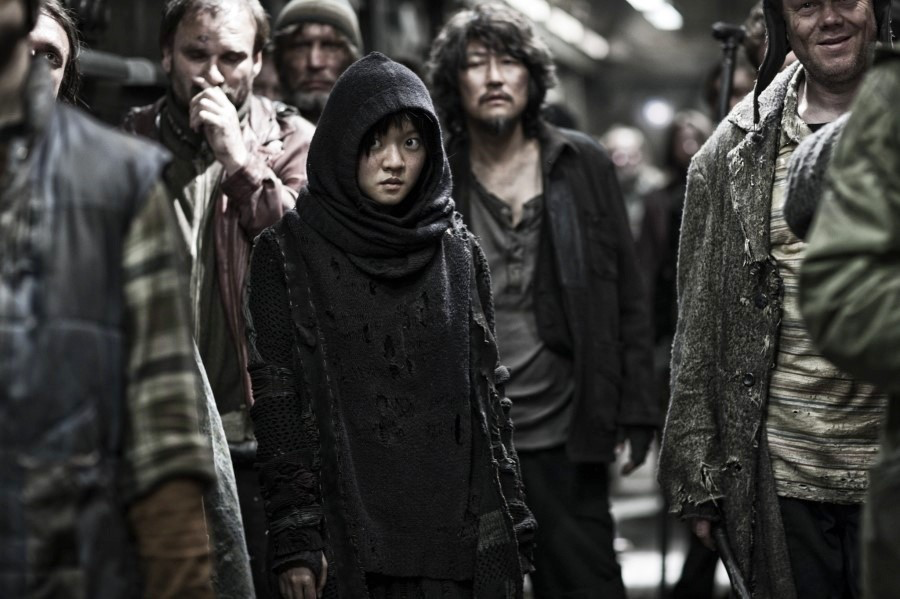
Yona, a girl with apparently supernatural powers, is one of the two survivors of the Rattling Arc. She is the daughter of the train’s former security architect, but who switches sides in support of the revolt. Source: movit.net
The end of the Arc’s civil war extinguished that world; in the Alpine expanse, a flicker of life as the two sole child denizens of the Arc – Yona and Timmy – land in the snow. For the first time they were not simply surviving on account of the designs of a Sovereign, but alive: aware of their shared sym-being made tangible by the alpine vastness and the life roaming about them. Encounter with reality outside the Arc revealed an Earth at once more vital than had been the case in the aftermath of the experiment, and far more vital than the ideology of the train’s guardians had permitted.
The encounter with Earth posed questions at once urgent in force but liberating in possibility, and to which no tyranny, state, or agency could imperiously claim for itself the role of arbiter-in-chief. The presumed impossibility of another world or life outside the Arc is revealed as error casting its two remaining kin into a white, snow-covered peace; an Adam and Eve exiled in a frozen white garden of rebirth. But when – if – cast- into the Garden, must there be another fall? Must sin be our origin-myth; repentance, obedience, and hierarchy our governing principles? Must sin beget sin, anti-politics beget anti-politics, hubris beget hubris? What kind of worlding in this garden, where survival must mean becoming-with, cautiously. Must Adam be a yoke on Yona’s flourishing?
Yona and Timmy are our prospective kin in earthly misfortune, as through a multiplicity of atrocities the Earth violently throws our ‘arc’ from the tracks along which we seem(-ed) to so seamlessly glide. The question is not whether our capital-A Arc is forced into an abyss, but which arcs – which worlds – are destroyed, for whom, and where. It is what tapestry of travesties is considered tolerable and necessary for the sake of the preservation of order – to keep the carnival rolling on – before alter-, sensible kinds of worlding-with are taken seriously. Alter ways-of-becoming necessarily political and necessarily hostile towards those baroque tyrannies so efficient for the dispossession and rule of the socio- ecological. For Tyrannocene.

The polar bear is shown roaming the landscape at the end of the film, when Yona and Timmy are cast out into the mountains expecting to be alone. Source: vulture.com
Snowpiercer ends without cosy comfort of closure. Being made to occupy the place of Yona and Timmy, the polar bear raises his deep kindly gaze down the barrel of the lens to us from the vantage point of the world-to-come. His white paradise frigid testimony to alpha-technoscientific recklessness: ‘my present is your future, so which battle do you choose? Will you be thrown-off Earth in your fanatical loyalty to a frail dis-order, accelerating towards its own finality? Or do you demand kindle a less Earth-hostile flourishing?’
A paw – graceful in its menace – reaches back to us in the present from a bear living and bearing-witness to prospective ecocide. Do we take this devilish offer of salvation and be hoisted by it – efficiently, securely – through catastrophe upon catastrophe, and beg to join the bear in white abyss, or furrow a new path? Whilst bearing the possibility and promise of Life, the polar bear’s eyes glisten with foreboding and reassurance, embodying the deeply unsettled, risky prospects for living after Arc. Here a possible companion for the long, difficult journey of re-co-living in conditions of ecological emergency. Do we wait to be tossed into a scorched Earth to grope for the bear’s receding paw in hurried desperation? Or act.
It wasn’t the bear that killed-off that world. Ignored in the frozen abyss, it was its shrouded tests and warnings left unheeded; the ideologies that occluded a reality that might have enabled a more truthful being-with. It was the ossified accountancy that computed that the bear’s offer of salvation was the only guarantee of a life in perpetuity. It was the multiplicity of weak-wills that staved-off plotting another path, seduced instead down the illicit shortcut: appealing in length and effort, but fateful in destination. And it won’t be the bear that ends our arcs. It will be the seductive generosity of its promise of life after. It will be shared failure to notice in his frozen land: we. The polar bear bears the weight of our ambivalence toward our situation: eking-out continued survival dutifully obeying the law whilst lusting after the possibility of a new beginning without questions. Without pause. To slog in anticipation of being saved; to obey law in anticipation of justice; to ruin in anticipation of paradise; to sin in anticipation of absolution.
For long may continue the carnival. The music still pumps – deafeningly, ceaselessly, determinedly – from the Arc’s middle compartments. The going is the goal, whispers Lewis Mumford, despairingly from the afterlife. Progress. Just one more revolution of the turntable before the last, secure in the knowledge of a bear’s paw to grasp. The going is the goal. One more gasp of water from the wellspring reduced to trickle, just one more child to toil in the machine. Just One More for Progress, for this carnival to roll-on. And Just One More recital of the myth: the awesome seed for a world where falsity reigns abundant steered by Wilford’s illusory strength. For Progress. Just One More, for this immortal Arc to advance into the ever-dimming dawn.
The music stops mid-beat to the harmonious wail of a choir of fools. I will be saved. And I will be saved. I too will be saved. Classed, divided, warring in life, the Arc-lings laboured and leisured away their fleeting existence for this peaceable consensus in premature death. Then, in the dreamy whiteness, the heraldic bear and its limited offer of salvation to a solitary pair, fades to black.
Exit Tyrannocene. Enter .
*Richard Bater has recently completed his doctorate at King’s College London. His thesis – Hydropolitik, or the Love of Abstraction: Anthropologies of water reform in Central Asia – draws on ethnographic work with a Central Asian environmental organisation to rethink the shifting character and topology of the global, the state, and regimes of environmental government/governance. More broadly he is interested in the immanent relationship between power, authority, knowledge, narrative, and earthly being(s).


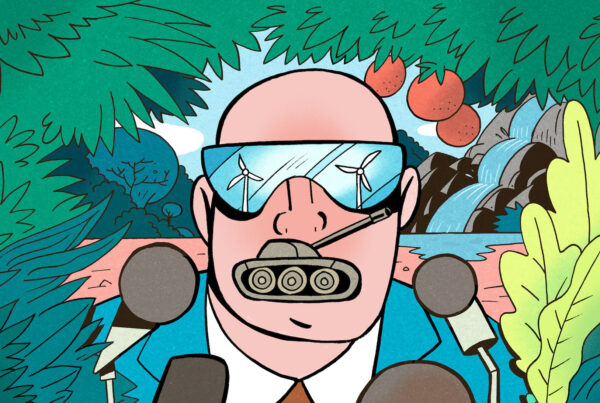
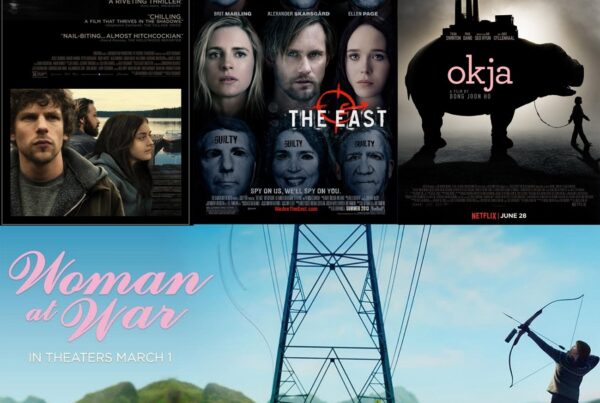
One Comment